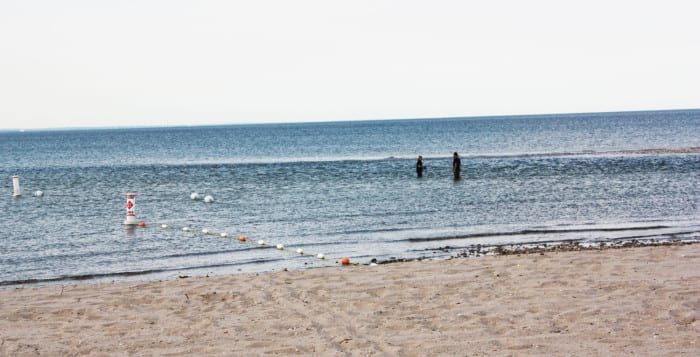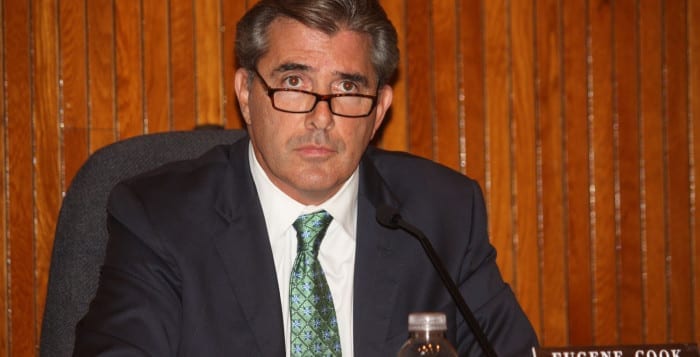Empty canvas
Between Aug. 21 at 4 p.m. and Aug. 30 at 5:45 p.m., an unknown person used spray paint to make graffiti on the walls of an unoccupied building on Hallock Avenue in Port Jefferson Station.
Cheap Jeep owner
On Aug. 26 at 3:30 p.m., a man in a white Jeep took a kayak from the back of another man’s Toyota truck. Police said the incident took place on Nesconset Highway in Port Jefferson Station.
Path to prison
A 32-year-old man from Port Jefferson Station was arrested on North Bicycle Path for grand larceny on Aug. 24, after police said he stole a credit card and made purchases at a Pathmark.
Conditioned to steal
Someone stole cash from a restaurant on Echo Avenue in Sound Beach between Aug. 25 at 10 p.m. and Aug. 26 at 7 a.m. The person climbed into the restaurant by removing an air conditioning unit from a window.
Please take your receipt
Police arrested a 53-year-old Calverton woman on Aug. 26 on Middle Country Road in Selden. Police said last year she found a receipt at a K-Mart, retrieved the listed items from around the store and pretended to return them, fraudulently receiving cash in exchange.
All-terrain thieves
Between Aug. 26 and 28, someone entered a residence on Friendship Drive in Rocky Point and took three all-terrain vehicles. Police said more than one thief was involved in the incident.
I saw it on television
Police said between Aug. 26 and 27 an unidentified person entered another individual’s house on 3rd Avenue in Rocky Point and stole a television.
License to repeat
A 57-year-old Coram man was arrested at Route 25A and West Gate Drive in Mount Sinai for driving with a suspended license on Aug. 27. Police said the man, who was driving a 1988 Oldsmobile Cutlass, has had his license suspended 10 times before.
Feetgum
Police said an unknown man kicked in a fence on Aug. 30 at a residence on Sweetgum Lane in Miller Place.
Meat me in prison
A 20-year-old man from Selden was arrested for reckless endangerment on Aug. 27 at 2:00 a.m., near Adirondack Avenue in Selden. Police said he had an altercation with a friend and threw a bottle of Windex and a bottle of meat marinade, which broke when it hit the floor. No one was injured.
Sleeping while intoxicated
On Aug. 27 at 1:37 a.m., police arrested a 21-year-old man from East Setauket for operating a motor vehicle while impaired by drugs. He was observed sleeping in the driver’s seat of a 2013 Toyota in Mount Sinai. Police said the man wasn’t steady on his feet and failed a sobriety test.
School of crime
Police arrested a 55-year-old man from Port Jefferson Station for criminal mischief. Authorities said he took a hammer and smashed the front passenger headlight and the windshield of a 2009 Suzuki SX4 on School Drive on Aug. 28 at 3:40 a.m.
Dozing driver
Police arrested a 23-year-old man from South Setauket on Aug. 29 for driving while ability impaired by drugs. The man was driving a 2001 Mitsubishi Galant down Route 25A in Centereach and passed out behind the wheel while waiting at a traffic light.
Hungry for cash
An unknown person shattered the glass on the front door of a restaurant on Middle Country Road in Centereach and broke into the building between Aug. 29 and 30. The individual stole cash and the cash box.
Between Aug. 27 at 10 p.m. and Aug. 28 at 6:45 a.m., an unidentified person broke into a restaurant on Route 25A in Miller Place. Police said the suspect broke the glass of the building’s front door and stole cash.
Simple physics
On the morning of Aug. 30, an unknown person damaged the rear passenger window on a 2010 Nissan. Police said the vehicle was damaged on Newton Avenue in Selden.
Give me Liberty
On Aug. 30 at 2:30 a.m. an unidentified person entered another person’s 2002 Ford Flex on Liberty Drive in Centereach and stole an iPod.
Dirty DWI
On Aug. 30 at 12:15 a.m., police arrested a 24-year-old man from Rocky Point for driving while intoxicated. Police said he was driving an unregistered Honda dirt bike on Noah’s Path in Rocky Point and that he was involved in a crash. It was not clear if anyone was hurt.
Stick ’em up
Suffolk County police arrested a 24-year-old man from Centereach in Setauket-East Setauket and charged him with first-degree robbery, burglary and seventh-degree criminal possession of a controlled substance. Police said that the man displayed a gun and stole cash and lotto tickets from OK Petroleum fuel station on Middle Country Road in Centereach on Aug. 23 at 2:35 a.m. Before that, he entered the bathroom of another gas station, BP fuel, using burglar’s tools, but he didn’t take anything. He was arrested on Aug. 27 at 3:43 p.m. when he was stopped at the parking lot in Home Depot on Pond Path in South Setauket, where cops found him with prescription drugs without a prescription.
Shopaholic stopped
A 48-year-old woman from Central Islip was arrested in Setauket-East Setauket on Aug. 26 and charged with petit larceny. Police said the woman took a gift bag, trading cards, Kool-Aid, board games and a bath rug and fled a Target on Pond Path. She was arrested at 4:11 p.m.
Lights out
Police arrested a 29-year-old man from Setauket and charged him with first-degree driving while intoxicated. Cops said that on Aug. 26 at 11 a.m., the man was driving a 2003 Jeep SUV westbound on Route 25A in Setauket and was pulled over because his rear taillight was out.
Chump change taken
An unknown person took change from a 1996 Honda on Sycamore Lane in Stony Brook, sometime between 3 and 11:30 a.m. on Aug. 29. There have been no arrests.
Identity stolen
Someone reported an incident of identity theft from Saddler Lane in Stony Brook on Aug. 29. The person told police that someone made two Internet purchases and an ATM withdrawal from the individual’s account between 8:50 and 9:01 a.m. on Aug. 25.
Wallet woes
A woman told police that someone removed cash from her wallet in her purse while at the Three Village Inn on Main Street in Stony Brook. Cops said the incident occurred sometime between 4:50 p.m. on Aug. 28 and noon on Aug. 29. There have been no arrests.
Shoot!
Someone took two camera lenses, a Nikon camera and assorted gift cards from a 2014 Acura MDX on Blinker Light Road in Stony Brook between 6 p.m. on Aug. 26 and 10 a.m. on Aug. 27. There have been no arrests.
Phone, change stolen
Someone entered an unlocked Honda on Driftwood Lane in Setauket-East Setauket and took a Verizon cell phone and change. The incident happened between Aug. 28 at 10 p.m. and Aug. 29 at 6 a.m.
Who’s keeping score?
Someone took a metal scoring table with steps and a bench from Ward Melville High School on Old Town Road in Setauket-East Setauket sometime between Aug. 16 and Aug. 27. There have been no arrests.
Police search for store thief
Suffolk County police are seeking the public’s help in identifying and locating a woman who stole items from a Commack store last month.
Police said a woman stole Chanel and Gucci perfume bottles from Ulta, located at 78 Veterans Memorial Highway, on July 30, at about 2:15 p.m. The perfumes had a combined value of approximately $750.
Police described the woman as dark skinned, with long black hair, approximately 5 feet 3 inches tall and wearing a blue T-shirt and jeans.
Suffolk County Crime Stoppers offers a cash reward of up to $5,000 for information that leads to an arrest. Anyone with information about this crime is asked to call anonymously to Crime Stoppers at 1-800-220-TIPS. All calls will be kept confidential.
Sheet out of luck
Suffolk County police arrested a 19-year-old Smithtown woman on Aug. 29 at the Smith Haven Mall and charged her with three counts of petit larceny. Cops said on June 17 and on June 21, she stole a sheet set and flat iron from T.J. Maxx on East Jericho Turnpike and both times returned them to the front desk for store credit. Police nabbed her on Aug. 29 at about 2 p.m. when she took various men’s Polo undergarments from Macy’s. She was arrested at about 2:30 p.m.
U-Gone
Someone rented a 2002 U-Haul trailer from a Smithtown location on Nesconset Highway and didn’t return the vehicle. Police said the incident occurred between June 19 and Aug. 28.
Buzz off
A woman told police that someone was leaving her harassing voicemails. The incident, reported on East Main Street in Smithtown on Aug. 28, occurred between the 27th at 9 a.m. and the 28th at 7:30 p.m.
Items taken
Someone stole items from the room of a nursing home on Route 25A in Smithtown sometime between Aug. 26 at 6 and 10 a.m. There have been no arrests.
Gadgets grabbed
Someone snagged a GPS and a DVD/CD player from a 2004 Dodge Ram 1500 pickup truck on Lancelot Court in St. James sometime on Aug. 24 at 10 p.m. and Aug. 29 at 9 a.m. There have been no arrests.
Door damaged
Someone keyed the front doors of a 1999 GMS on Lincoln Avenue in Kings Park, sometime between Aug. 28 at 3 p.m. and Aug. 29 at noon. There have been no arrests.
Laptop, smash-top
Someone smashed the rear passenger window of a 2002 Chevrolet TrailBlazer on Nesconset Highway and stole a laptop and two credit cards sometime on Aug. 27 between 5 and 11:10 p.m.
Drugs galore
Two 25-year-old men from Huntington were arrested on the corner of West 4th Street and 3rd Avenue in Huntington Station on Aug. 29 at 7 p.m. One man was charged with possession of marijuana, and the other man was charged with seventh-degree criminal possession of a controlled substance, for possessing prescription pills without a prescription.
Blurred lines
A 47-year-old Huntington man was arrested for driving while intoxicated driving westbound on Fairmount Street in Huntington, on Aug. 29 at about 3 a.m. He was driving a 2012 white Mercedes and was observed swerving outside the travel lanes.
Boats and woes
A unknown person stole a watch, laptop, television, toaster, sunglasses and earrings from a boat docked at Knutson Marine in Halesite. The incident was reported on Aug. 29 at 6 p.m.
Life’s a beach
A wallet was stolen from a doorless and topless 1998 Jeep parked at Crab Meadow Beach in Northport on Aug. 28. The wallet contained cash, a driver’s license and a debit card.


















